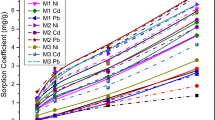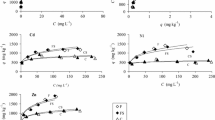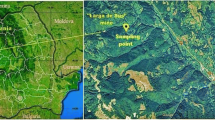Abstract
Contamination of environmental matrixes by human and animal wastes containing antibiotics is a growing health concern. Because tetracycline is one of the most widely-used antibiotics in the world, it is important to understand the factors that influence its mobility in soils. This study investigated the effects of pH, background electrolyte cations (Li+, Na+, K+, Ca2+ and Mg2+), heavy metal Cu2+ and humic acid (HA) on tetracycline adsorption onto kaolinite. Results showed that tetracycline was greatly adsorbed by kaolinite over pH 3–6, then decreased with the increase of pH, indicating that tetracycline adsorption mainly through ion exchange of cations species and complexation of zwitterions species. In the presence of five types of cations (Li+, Na+, K+, Ca2+ and Mg2+), tetracycline adsorption decreased in accordance with the increasing of atomic radius and valence of metal cations, which suggested that outer-sphere complexes formed between tetracycline and kaolinite, and the existence of competitor ions lead to the decreasing adsorption. The presence of Cu2+ greatly enhanced the adsorption probably by acting as a bridge ion between tetracycline species and the edge sites of kaolinite. HA also showed a major effect on the adsorption: at pH < 6, the presence of HA increased the adsorption, while the addition of HA showed little effect on tetracycline adsorption at higher pH. The soil environmental conditions, like pH, metal cations and soil organic matter, strongly influence the adsorption behavior of tetracycline onto kaolinite and need to be considered when assessing the environmental toxicity of tetracycline.






Similar content being viewed by others
References
Bound JP, Voulvoulis N (2004) Pharmaceuticals in the aquatic environment—a comparison of risk assessment strategies. Chemosphere 56:1143–1155
Brady PV, Cygan RT, Nagy KL (1996) Molecular controls on kaolinite surface charge. J Colloid Interface Sci 183(2):356–364
Carty WM (1999) The colloidal nature of kaolinite. Am Ceram Soc Bull 78(8):72–76
Chen WR, Huang CH (2010) Adsorption and transformation of tetracycline antibiotics with aluminum oxide. Chemosphere 79(8):779–785. doi:10.1016/j.chemosphere.2010.03.020
Chen Y, Hu C, Qu JH, Yang M (2008) Photodegradation of tetracycline and formation of reactive oxygen species in aqueous tetracycline solution under simulated sunlight irradiation. J Photochem Photobiol A Chem 197(1):81–87. doi:10.1016/j.jphotochem.2007.12.007
Figueroa RA, Mackay AA (2005) Sorption of oxytetracycline to iron oxides and iron oxide-rich soils. Environ Sci Technol 39(17):6664–6671. doi:10.1021/es048044l
Figueroa RA, Leonard A, Mackay AA (2004) Modeling tetracycline antibiotic sorption to clays. Environ Sci Technol 38(2):476–483
Grossl PR, Sparks DL, Ainsworth CC (1994) Rapid kinetics of Cu(II) adsorption-desorption on goethite. Environ Sci Technol 28(8):1422–1429
Gu XY, Evans LJ (2008) Surface complexation modelling of Cd(II), Cu(II), Ni(II), Pb(II) and Zn(II) adsorption onto kaolinite. Geochim Cosmochim Acta 72(2):267–276. doi:10.1016/j.gca.2007.09.032
Gu C, Karthikeyan KG (2005) Interaction of tetracycline with aluminum and iron hydrous oxides. Environ Sci Technol 39(8):2660–2667
Gu C, Karthikeyan KG (2008) Sorption of the antibiotic tetracycline to humic-mineral complexes. J Environ Qual 37(2):704–711. doi:10.2134/jeq2007.0030
Gu C, Karthikeyan KG, Sibley SD, Pedersen JA (2007) Complexation of the antibiotic tetracycline with humic acid. Chemosphere 66(8):1494–1501. doi:10.1016/j.chemosphere.2006.08.028
Hamscher G, Sczesny S, Höper H, Nau H (2002) Determination of persistent tetracycline residues in soil fertilized with liquid manure by high-performance liquid chromatography with electrospray with electrospray ionization tandem mass spectrometry. Anal Chem 74:1509–1518
Ho YS (2006) Review of second-order models for adsorption systems. J Hazard Mater 136(3):681–689. doi:10.1016/j.jhazmat.2005.12.043
Ji LL, Chen W, Duan L, Zhu DQ (2009) Mechanisms for strong adsorption of tetracycline to carbon nanotubes: a comparative study using activated carbon and graphite as adsorbents. Environ Sci Technol 43(7):2322–2327. doi:10.1021/es803268b
Jia DA, Zhou DM, Wang YJ, Zhu HW, Chen JL (2008) Adsorption and cosorption of Cu(II) and tetracycline on two soils with different characteristics. Geoderma 146(1–2):224–230. doi:10.1016/j.geoderma.2008.05.023
Kim SC, Carlson K (2007) Temporal and spatial trends in the occurrence of human and veterinary antibiotics in aqueous and river sediment matrices. Environ Sci Technol 41:50–57. doi:10.1021/es060737+
Kolpin DW et al (2002) Pharmaceuticals, hormones, and other organic wastewater contaminants in US streams, 1999–2000: a national reconnaissance. Environ Sci Technol 36:1202–1211
Kulshrestha P, Giese RF, Aga DS (2004) Investigating the molecular interactions of oxytetracycline in clay and organic matter: insights on factors affecting its mobility in soil. Environ Sci Technol 38(15):4097–4105. doi:10.1021/es034856q
Li ZH, Chang PH, Jean JS, Jiang WT, Wang CJ (2010) Interaction between tetracycline and smectite in aqueous solution. J Colloid Interface Sci 341(2):311–319. doi:10.1016/j.jcis.2009.09.054
Manjaiah KM, Kumar S, Sachdev MS, Sachdev P, Datta SC (1998) Study of clay-organic complexes. Curr Sci 98, 915–921
McKeague JA (1978) Manual on soil sampling and methods of analysis, 2nd edn. Canadian Society of Soil Science, Ottawa, p 212
Parolo ME, Savini MC, Valles JM, Baschini MT, Avena MJ (2008) Tetracycline adsorption on montmorillonite: pH and ionic strength effects. Appl Clay Sci 40(1–4):179–186. doi:10.1016/j.clay.2007.08.003
Parolo ME, Avena MJ, Pettinari G, Zajonkovsky I, Valles JM, Baschini MT (2010) Antimicrobial properties of tetracycline and minocycline-montmorillonites. Appl Clay Sci 49(3):194–199. doi:10.1016/j.clay.2010.05.005
Pils JRV, Laird DA (2007) Sorption of tetracycline and chlortetracycline on K- and Ca-saturated soil clays, humic substances, and clay-humic complexes. Environ Sci Technol 41(6):1928–1933. doi:10.1021/es062316y
Sarmah AK, Meyer MT, Boxall ABA (2006) A global perspective on the use, sales, exposure pathways, occurrence, fate and effects of veterinary antibiotics (VAs) in the environment. Chemosphere 65(5):725–759. doi:10.1016/j.chemosphere.2006.03.026
Sithole BB, Guy RD (1987a) Models for tetracycline in aquatic environments. 1. Interaction with bentonite clay systems. Water Air Soil Pollut 32(3-4):303–314
Sithole BB, Guy RD (1987b) Models for tetracycline in aquatic environments. 2. Interaction with humic substances. Water Air Soil Pollut 32(3-4):315–321
Swedlund PJ, Webster JG, Miskelly GM (2009) Goethite adsorption of Cu(II), Pb(II), Cd(II), and Zn(II) in the presence of sulfate: properties of the ternary complex. Geochim Cosmochim Acta 73(6):1548–1562. doi:10.1016/j.gca.2008.12.007
Tombacz E, Libor Z, Illes E, Majzik A, Klumpp E (2004) The role of reactive surface sites and complexation by humic acids in the interaction of clay mineral and iron oxide particles. Org Geochem 35(3):257–267. doi:10.1016/j.orggeochem.2003.11.002
Wang YJ, Jia DA, Sun RJ, Zhu HW, Zhou DM (2008) Adsorption and cosorption of tetracycline and copper(II) on montmorillonite as affected by solution pH. Environ Sci Technol 42(9):3254–3259. doi:10.1021/es702641a
Wang JT, Hu J, Zhang SW (2010) Studies on the sorption of tetracycline onto clays and marine sediment from seawater. J Colloid Interf Sci 349(2):578–582. doi:10.1016/j.jcis.2010.04.081
Zhao L, Dong YH, Wang H (2010) Residues of veterinary antibiotics in manures from feedlot livestock in eight provinces of China. Sci Total Environ 408(5):1069–1075. doi:10.1016/j.scitotenv.2009.11.014
Acknowledgments
This study was financially supported by the National Natural Science Foundation of China (No. 20807022), and the Key Special Program on the Science and Technology for the Pollution Control and Treatment of Water Bodies (No. 2009ZX07210-004, 2008ZX07316-004).
Author information
Authors and Affiliations
Corresponding authors
Rights and permissions
About this article
Cite this article
Zhao, Y., Geng, J., Wang, X. et al. Tetracycline adsorption on kaolinite: pH, metal cations and humic acid effects. Ecotoxicology 20, 1141–1147 (2011). https://doi.org/10.1007/s10646-011-0665-6
Accepted:
Published:
Issue Date:
DOI: https://doi.org/10.1007/s10646-011-0665-6




